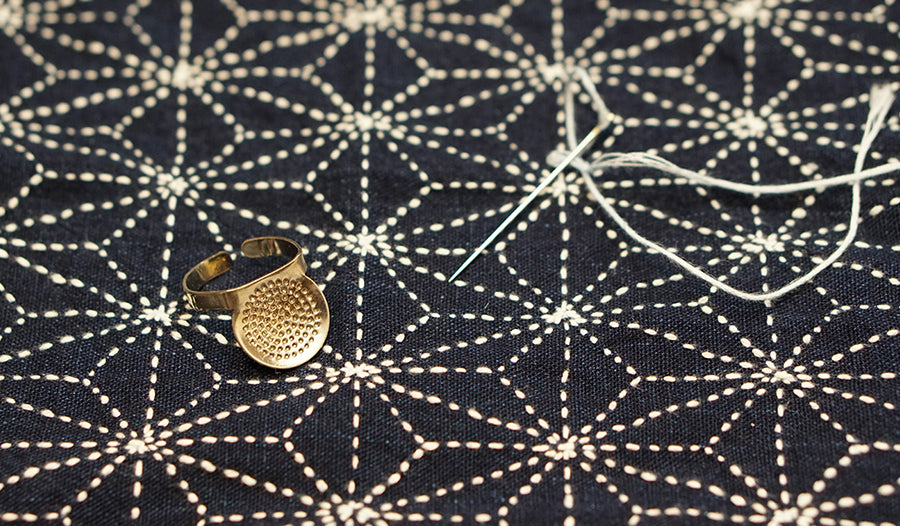
SASHIKO AND MENDING

When I read articles about Sashiko in English, I occasionally find insufficient definitions accompanying it: “Sashiko is a Japanese mending technique”. This is not entirely wrong — mending is an important part of Sashiko. However, the primary essence of Sashiko is not mending. The Japanese stitched in this way to make fabric thicker, stronger, and warmer to avoid further mending, because they knew they would need to mend eventually. Sashiko is the practice of appreciating the fabric while trying to minimize and stave off the process of mending.
The Japanese practiced Sashiko to make fabric more durable in harsh conditions (such as severe winter) with very limited resources. They did not have the luxury of replacing worn out fabric so they stitched to make the fabric last longer. Some practiced this on the same garment over generations, stitching and mending, and the result of this repetitive Sashiko is known as “Boro”.

In today's society we have choice. The current ‘trend’ and return to mending is encouraging in a climate where tonnes of garments are needlessly sent to landfill every year. However it is important to distinguish the long history of the Japanese practice of Sashiko to avoid appropriating it and resulting in the loss of the deep cultural meaning around the word. Sashiko is, indeed, a form of stitching to appreciate fabric. Mending is an important part of Sashiko. However, Sashiko is not the word for mending itself — it is much more than that.
First of all, practitioners of Sashiko stitched geometric patterns first to make the fabric stronger to avoid mending in future. When I work on the denim, I try to follow this original practice by stitching the denim first. Inevitably, after wearing denim for a while, mending will become necessary but my initial intention is to avoid mending.

When people focus on the materialistic result of “how Sashiko looks” the cultural significance is ignored. Some damage their own denim with a flat file or sand-paper, subsequently stitch over the damage and call it Sashiko. It is okay to call the stitching Sashiko, but damaging the fabric is not the primary essence of it, in some ways, it is in complete opposition to the spirit of Sashiko.
Mending is a precious practice that inherently comes from a place of caring. We stitch to mend fabric because we care for it, or even the people who use the fabric. Therefore, I want them to be careful in the usage of appropriating cultural words. Focusing on the artistic perspective of Sashiko can minimize the voice of Japanese Sashiko Artisans, especially in English language western culture.

I'm so pleased that Sashiko and Boro have become so well known and practiced in recent years. However, there are some people who intentionally modify cultural history of both for their convenience. They distort cultural practices like Sashiko into something easier to understand: something to satisfy the instant gratification the market is waiting for. For me, mending is not only a practice of “repairing” fabric but a precious time to mend ourselves. Since I know we all mend the fabric with good intention, I am here to share Sashiko Stories so that they do not harm Japanese culture unintentionally.
I want everyone to enjoy Sashiko. All I am asking for is the acknowledgment of the whole picture of Sashiko before defining the cultural practice based on their convenience & profit.

I appreciate that culture is supposed to alter its form over time, yet I hope the change will be done with good intention and caring, not with ignorance and indifference. Menders inherently care about material sustainability. It is not such a huge jump to also care about cultural sustainability.
Sashiko is a beautiful practice to appreciate the fabric. Mending is an important aspect of Sashiko. Boro is one significant result of Sashiko mending. I want the world to acknowledge that Sashiko is more than what is now introduced in English.
Written by Atsushi Futatsuya
--
Find out more about Atsushi on his website: The beauty of Sashiko | Upcycle and Repurpose - Upcycle Stitches
Follow him on Instagram: @SashikoStory
Atsushi will be running his sell-out workshop on Sashiko Stitching once again on Saturday 28 and Sunday 29 May 2022. Don't miss out! There's only a few places left and booking must close at the end of the week.

